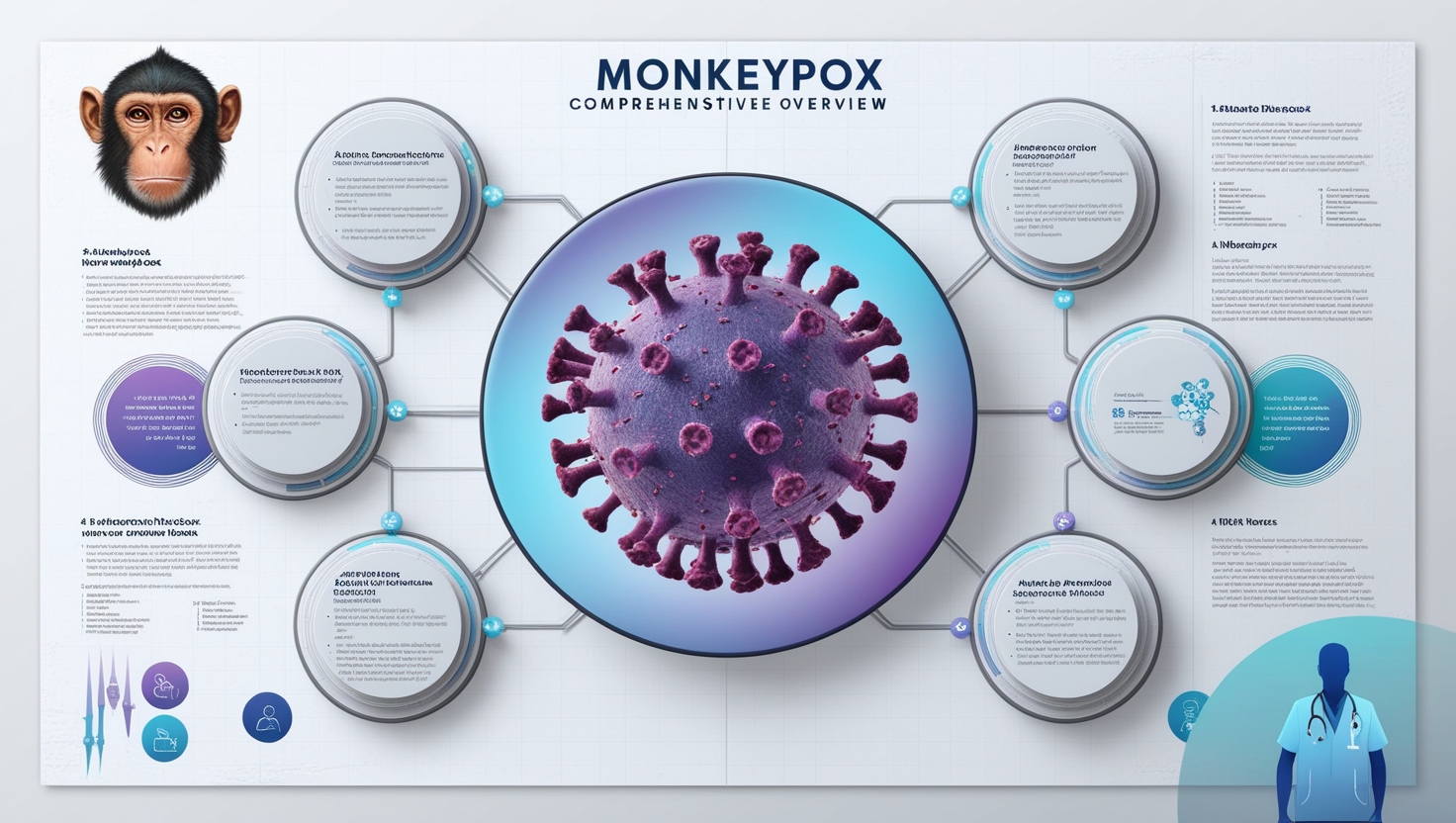Understanding Monkeypox: A Comprehensive Overview

Introduction
Monkeypox is a newly recognized viral zoonotic disease resulting from the monkeypox virus, classified within the Orthopoxvirus genus. The same family includes the viruses responsible for smallpox and cowpox. While it is generally less severe than smallpox, monkeypox poses a significant public health threat due to its ability to trigger outbreaks, particularly in areas with inadequate healthcare infrastructure. This article examines the history, modes of transmission, symptoms, preventive measures, and the current global status of monkeypox.
Historical Background
Monkeypox was initially recognized in 1958 following two incidents of a pox-like illness in research monkeys. The first documented human infection occurred in 1970 in the Democratic Republic of Congo (DRC), coinciding with the global smallpox eradication campaign. Since that time, most reported cases have been concentrated in Central and West Africa, especially in the DRC, where the disease is now regarded as endemic.
Transmission
Monkeypox is mainly classified as a zoonotic disease, indicating that it is spread from animals to humans. The main animal carriers are thought to be rodents and primates, such as monkeys and squirrels. Transmission between humans can take place through:
- Direct contact with bodily fluids or lesions: This includes skin-to-skin contact with infected individuals.
- Respiratory droplets: Prolonged face-to-face contact with an infected person can lead to transmission through respiratory droplets.
- Contaminated objects: Handling clothing, bedding, or other materials contaminated with the virus can result in infection.
- Mother-to-child transmission: This can occur through the placenta (congenital monkeypox) or during close contact during and after birth.
Symptoms
The symptoms of monkeypox are similar to, but milder than, those of smallpox. The incubation period (from infection to symptoms) is typically 6 to 13 days but can range from 5 to 21 days. The disease progresses through several stages:
- Initial Symptoms:
- Fever
- Headache
- Muscle aches
- Backache
- Swollen lymph nodes
- Chills
- Exhaustion
- Rash Development:
- Within 1 to 3 days after the appearance of fever, a rash develops, often starting on the face before spreading to other parts of the body.
- The rash progresses through different stages—macules, papules, vesicles, pustules, and finally, scabs, which eventually fall off.
The duration of the illness generally ranges from 2 to 4 weeks, with the majority of patients recovering without the need for medical intervention. Nevertheless, severe instances may arise, particularly among children and those with weakened immune systems.
Diagnosis
Monkeypox can be diagnosed through clinical evaluation and laboratory tests. Polymerase chain reaction (PCR) testing of lesion samples is the most accurate method for confirming the diagnosis. Serological testing may also be used, although cross-reactivity with other Orthopoxviruses can complicate the interpretation of results.
Treatment and Prevention
There is currently no specific treatment for monkeypox, but supportive care and treatment of symptoms can significantly improve outcomes. Antiviral medications like tecovirimat, initially developed for smallpox, may be effective, but more research is needed.
Prevention strategies include:
- Vaccination: The smallpox vaccine has been shown to be about 85% effective in preventing monkeypox. Newer vaccines, such as the JYNNEOS (also known as Imvamune or Imvanex), are specifically licensed for monkeypox prevention.
- Reducing exposure to wildlife: Limiting contact with potentially infected animals and practicing good hygiene after handling animals or animal products is crucial.
- Public health measures: Isolation of infected individuals, use of personal protective equipment (PPE), and contact tracing are essential in controlling outbreaks.
Global Situation and Public Health Response
Monkeypox cases have been sporadically reported outside Africa, often linked to international travel or the importation of animals. However, a significant outbreak in 2022 saw cases reported in multiple countries across Europe, North America, and other regions, raising concerns about global spread.
The World Health Organization (WHO) and other public health agencies have emphasized the importance of surveillance, vaccination, and public awareness in managing and preventing monkeypox outbreaks. Research is ongoing to better understand the virus, its transmission, and effective countermeasures.

Conclusion
Monkeypox, while less deadly than smallpox, remains a significant public health challenge, particularly in regions with limited healthcare infrastructure. Understanding its transmission, symptoms, and prevention methods is crucial for managing outbreaks and reducing the risk of global spread. Continued research and international cooperation are essential in the fight against this emerging infectious disease.
References
- World Health Organization. (2022). Monkeypox: Key facts. Retrieved from https://www.who.int/news-room/fact-sheets/detail/monkeypox
- Centers for Disease Control and Prevention. (2022). Monkeypox. Retrieved from https://www.cdc.gov/poxvirus/monkeypox/index.html
- Simpson, K., Heymann, D., Brown, C. S., Edmunds, W. J., Elsgaard, J., Fine, P., … & Endo, A. (2020). Human monkeypox–After 40 years, an unintended consequence of smallpox eradication. Vaccine, 38(33), 5077-5081.
- McCollum, A. M., & Damon, I. K. (2014). Human monkeypox. Clinical Infectious Diseases, 58(2), 260-267.
If you Liked Reading our Blog Read More Blogs Here and Below is the Link to our WhatsApp channel Join it for the Latest Post Updates. (Read For WhatsApp Channel Privacy and Security Here).
UseFull Resources:
| Resources | Resources |
|---|---|
| Tooldar: Tooldar | Hemingway Editor: Hemingway Editor |
| Ilovepdf3: Ilovepdf3 | Grammarly: Grammarly |
| Adorepdf: Adorepdf | Coursera: Coursera |
| Custom Design Agency: Articon Design Agency | Udemy: Udemy |
| Google: Google | Khan Academy: Khan Academy |
| Yandex: Yandex | Wolfram Alpha: Wolfram Alpha |
| Baidu: Baidu | TED Talks: TED Talks |
| Medium: Medium | Skillshare: Skillshare |
| Quora: Quora | Canva: Canva |
| Duolingo: Duolingo | Figma: Figma |
| Nerdfitness: Nerdfitness | Trello: Trello |
| DeepL: DeepL | Notion: Notion |
| LinkedIn: LinkedIn | Asana: Asana |
| Stack Overflow: Stack Overflow | Mailchimp: Mailchimp |
| GitHub: GitHub | Zapier: Zapier |
Note : These Above Resources Are just for Educational and ease of use Purposes we neither Endorse them, they were working at the time of sharing.
.Disclaimer: The information presented in this blog is for educational and informational purposes only and should not be considered financial, Political, or cultural advice. All efforts have been made to ensure the accuracy of the content at the time of writing.
Think We Missed Something?
If you notice an error or have a suggestion, we encourage you to submit a correction. Help us keep our information up-to-date and reliable!











